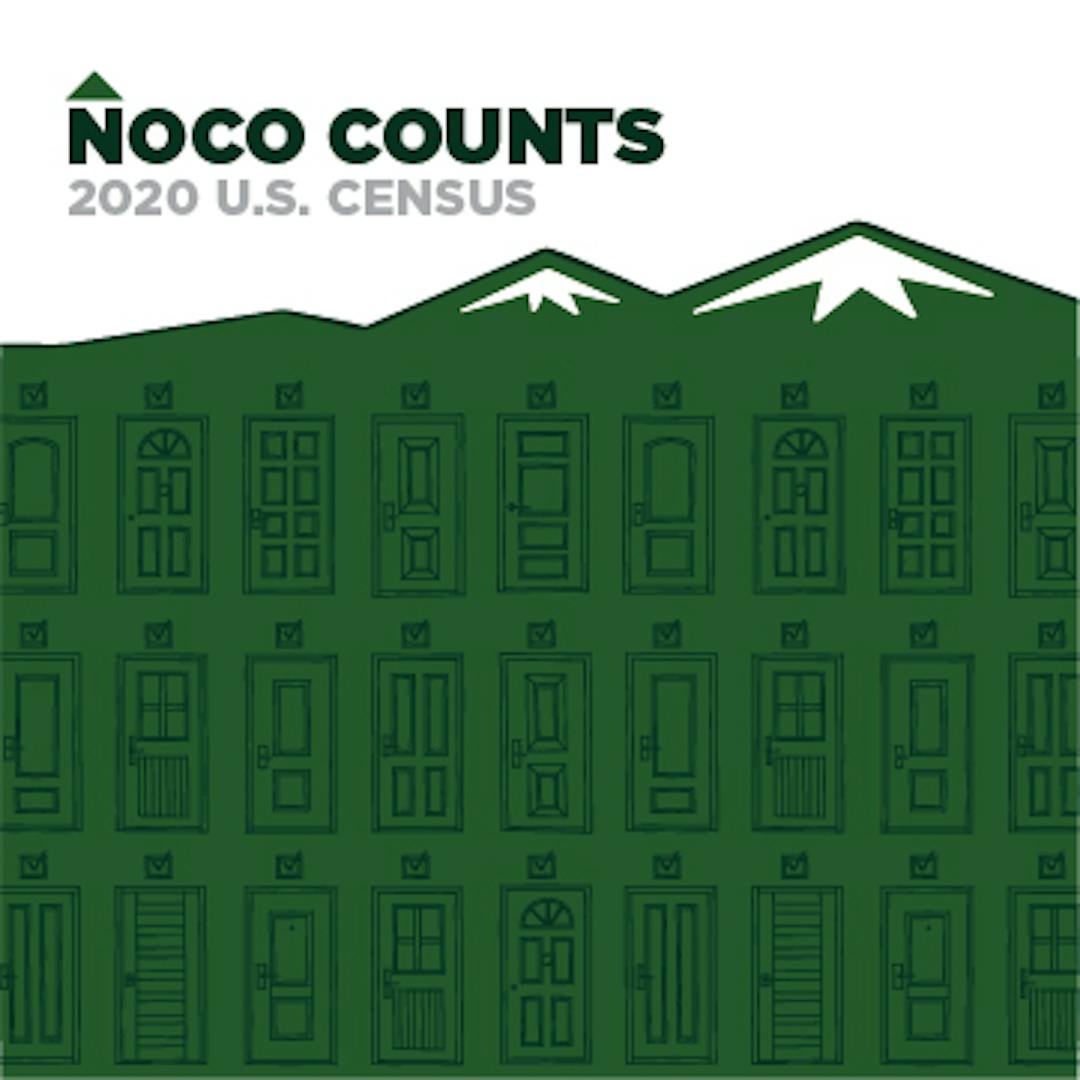NoCo Counts
Consultation has concluded

Complete your 2020 Census online today!
The next U.S. Census is April 1, 2020. Once a decade, every resident in the United States has a chance to counted. Census results are used to reapportion congressional seats and to distribute more than $675 billion in federal funding supporting housing, education, healthcare, and employment.
The success of the census and ensuring Fort Collins receives appropriate federal funding depends on everyone participating.
Complete your 2020 Census online today!
The next U.S. Census is April 1, 2020. Once a decade, every resident in the United States has a chance to counted. Census results are used to reapportion congressional seats and to distribute more than $675 billion in federal funding supporting housing, education, healthcare, and employment.
The success of the census and ensuring Fort Collins receives appropriate federal funding depends on everyone participating.
-
Counting College Students during school closures due to COVID-19
Share Counting College Students during school closures due to COVID-19 on Facebook Share Counting College Students during school closures due to COVID-19 on Twitter Share Counting College Students during school closures due to COVID-19 on Linkedin Email Counting College Students during school closures due to COVID-19 linkIn general, students in colleges and universities temporarily closed due to the COVID-19 virus will still be counted as part of this process. Even if they are not at school on census day, April 1, they should be counted where they live and sleep most of the time. We are asking schools to contact their students and remind them to respond.
-
The Census and COVID-19
Share The Census and COVID-19 on Facebook Share The Census and COVID-19 on Twitter Share The Census and COVID-19 on Linkedin Email The Census and COVID-19 linkThe U.S. Census Bureau is monitoring coronavirus (COVID-19) carefully, and the health, safety and well-being of the public and our staff is our top priority.
-
18- to 24-Year-Olds Who Don’t Live With Parents Are Hard to Count
Share 18- to 24-Year-Olds Who Don’t Live With Parents Are Hard to Count on Facebook Share 18- to 24-Year-Olds Who Don’t Live With Parents Are Hard to Count on Twitter Share 18- to 24-Year-Olds Who Don’t Live With Parents Are Hard to Count on Linkedin Email 18- to 24-Year-Olds Who Don’t Live With Parents Are Hard to Count linkMore than half of the 18- to 24-year-olds in the United States live with their parents and will be counted in their parents’ home when the 2020 Census begins this spring.
The other 45% of young adults don’t live at home and are considered less likely to respond because they are what the U.S. Census Bureau calls “young and mobile.”
-
2020 Census Will Inform Funding for Environmental Programs, Including Mass Transit
Share 2020 Census Will Inform Funding for Environmental Programs, Including Mass Transit on Facebook Share 2020 Census Will Inform Funding for Environmental Programs, Including Mass Transit on Twitter Share 2020 Census Will Inform Funding for Environmental Programs, Including Mass Transit on Linkedin Email 2020 Census Will Inform Funding for Environmental Programs, Including Mass Transit linkCities across the United States striving to reduce their carbon footprints are awaiting results from the 2020 Census to help plan public funding of “green” programs.
Reducing a city’s environmental impact is one way census responses can shape the future of critical public services in communities. Responses to the 2020 Census will inform funding for programs such as Federal Transit Capital Investment Grants that can be used for public transportation and Water Pollution Control grants.
-
Census Partners With Social Media Platforms, Community Organizations, the Public to Stop Spread of False Information
Share Census Partners With Social Media Platforms, Community Organizations, the Public to Stop Spread of False Information on Facebook Share Census Partners With Social Media Platforms, Community Organizations, the Public to Stop Spread of False Information on Twitter Share Census Partners With Social Media Platforms, Community Organizations, the Public to Stop Spread of False Information on Linkedin Email Census Partners With Social Media Platforms, Community Organizations, the Public to Stop Spread of False Information linkEvery decade, technology plays a greater role in the way the census is conducted. But in 2020, the first time anyone who wants to respond to the census online has that option, the greatest change may come from the way all of us use technology.
For the first time during a decennial census, the majority of people in the United States are using digital and social media in their everyday lives.
-
Spending on Pet Care Services Doubled in Last Decade
Share Spending on Pet Care Services Doubled in Last Decade on Facebook Share Spending on Pet Care Services Doubled in Last Decade on Twitter Share Spending on Pet Care Services Doubled in Last Decade on Linkedin Email Spending on Pet Care Services Doubled in Last Decade linkDo you need a dog walker for Rocky, a cat sitter for Bella or training for Buddy?
Half (about 60 million) of American households own pets and the amount of money they spend on their four-legged friends is evidence of the growing need for time-saving pet care services.
Over the decade ending in 2017, sales of pet care services doubled, to a total of $5.8 billion, according to the latest Economic Census statistics.
-
How to Count College Students in 2020 Census
Share How to Count College Students in 2020 Census on Facebook Share How to Count College Students in 2020 Census on Twitter Share How to Count College Students in 2020 Census on Linkedin Email How to Count College Students in 2020 Census linkA freshman living on campus in student housing. A junior varsity athlete sharing an off-campus house with teammates. A senior living solo in an off-campus apartment.
Even though many residents of a typical American college town might move away after they graduate, they have to be counted while they live there.
College towns across the country depend on students’ responses to the census. The reason: Census results help determine how much federal funding communities will receive over the next 10 years.
-
By 2030 All Baby Boomers Will be Age 65 or Older
Share By 2030 All Baby Boomers Will be Age 65 or Older on Facebook Share By 2030 All Baby Boomers Will be Age 65 or Older on Twitter Share By 2030 All Baby Boomers Will be Age 65 or Older on Linkedin Email By 2030 All Baby Boomers Will be Age 65 or Older linkBaby boomers have changed the face of the U.S. population for more than 70 years and continue to do so as more enter their senior years, a demographic shift often referred to as a “gray tsunami.”
Knowing about the number of people age 65 and older is important for tribal, local, state and federal lawmakers. They will use 2020 Census statistics to help decide how to spend billions of dollars annually in federal funds on critical public services for the next 10 years.
-
2020 Census Count Guides Funding of New Roads and Bridges
Share 2020 Census Count Guides Funding of New Roads and Bridges on Facebook Share 2020 Census Count Guides Funding of New Roads and Bridges on Twitter Share 2020 Census Count Guides Funding of New Roads and Bridges on Linkedin Email 2020 Census Count Guides Funding of New Roads and Bridges linkNext time you’re on your morning commute, merging on to a freeway or crossing a bridge, think of the decennial census.
Your responses to the 2020 Census, which includes every person living in the United States, may help decide when and where roads and bridges will be built in your community.
Many states rely on population numbers from the census taken once every 10 years to allocate revenue from gasoline sales taxes, one of the primary sources of funding for local roads.
-
School Enrollment: College Down, Graduate School Up
Share School Enrollment: College Down, Graduate School Up on Facebook Share School Enrollment: College Down, Graduate School Up on Twitter Share School Enrollment: College Down, Graduate School Up on Linkedin Email School Enrollment: College Down, Graduate School Up linkDespite an overall decline in school enrollment, the number of people enrolled in graduate and professional school in the United States jumped 8.1% from 2011 to 2018.
Important Links
Who's listening
-

Phone 970-224-6094 Email hdepew@fcgov.com -

Phone 9702216264 Email lescalante@fcgov.com



